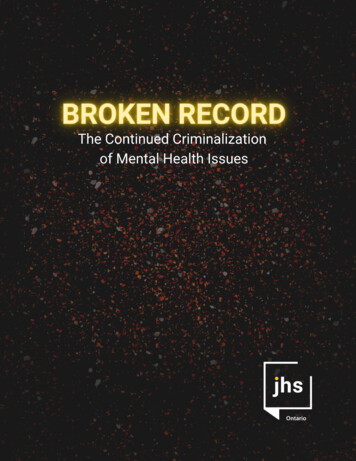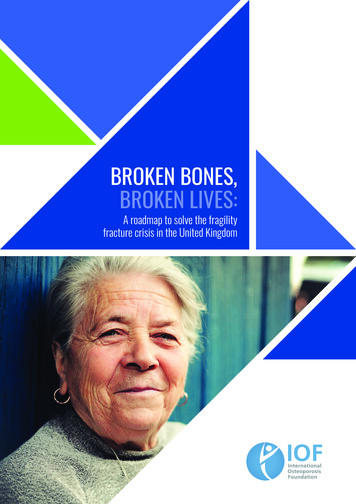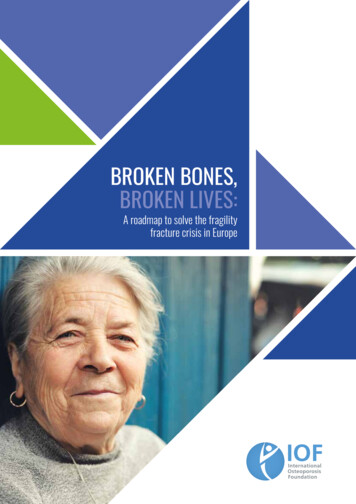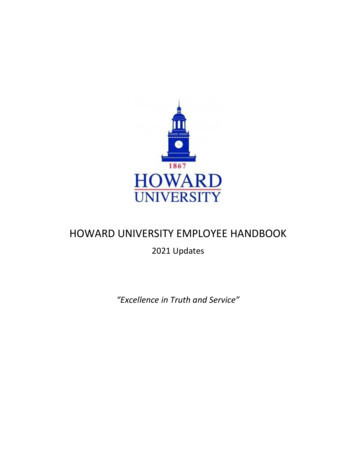
Transcription
1BROKEN RECORDCover
BROKEN RECORDABOUT USFor more than 90 years, the John Howard Society of Ontario has worked tokeep the humanity in justice.Today we continue to build a safer Ontario by supporting the people andcommunities affected by the criminal justice system. Our 19 local officesdeliver more than 80 evidence-based programs and services focused onprevention, intervention and reintegration across the province. These rangefrom helping youth develop the life skills that will let them achieve their fullpotential, to assisting families navigate issues of criminal justice, toproviding job training for those leaving incarceration so they can contributeto their community in a meaningful way. We promote practical, humanepolicies while raising awareness of the root causes of crime and calling onOntarians to share responsibility for addressing them. Within our criminaljustice system, we work toward the fair treatment of all. As the systemevolves to reflect our changing society, we ensure that no one is left behind.We believe that policy should be grounded in the day-to-day reality of thepeople it impacts. That’s why our Centre of Research & Policy specializesin bridging the gap between analysis and frontline service delivery. Bycollaborating closely with our local offices, the Centre’s team of analystsand researchers develops policy positions that truly reflect the needs ofeach community, advances those positions to governments and otherorganizations, educates the public on the critical issues, and evaluatesprogram efficacy to guide future work. Through it all, they're committed toensuring that innovative ideas can translate into real itter.com/jhsontario2
3BROKEN RECORDACKNOWLEDGEMENTSThe John Howard Society of Ontario would like to sincerely thank thefamilies and individuals who reached out to us following the release ofour 2015 report, Unlocking Change: Decriminalizing Mental HealthIssues in Ontario. Your poignant, often tragic recounts of experienceswith mental illness, substance use disorders and criminalizationunderscored the real-life costs of our current system, and the urgentneed for change. The searing humanity behind your stories, the cries forhelp that too often went unanswered, and the stigma, compelled us toundertake this follow-up project.In addition, we would like to gratefully acknowledge the significantcontributions of JHSO Volunteers Alisha Salerno, Nicole Lefaive andJoanna Richards which greatly assisted in the development of thisreport and our interactive website. We would also like to thank the staffand clients of JHS in Toronto who spoke to us, as well as JenniferChambers of The Empowerment Council at CAMH.Lastly – though certainly not least – we want to acknowledge theincredible work and time contributed by Helios Design Lab. Theirextraordinary creative work brought the story of Broken Record to life ina most inspired way.
BROKEN RECORDTABLE OF CONTENTSABOUT US . 2ACKNOWLEDGEMENTS . 3TABLE OF CONTENTS . 4WHAT IS MENTAL HEALTH . 5INTRODUCTION . 6POLICE . 8COURTS & BAIL . 10JAIL . 13BREAKING THE CYCLE: SHIFTING THE STATUS QUO . 18Respond to Mental Health Issues like Physical Health Issues.19Raise the Threshold to Criminal Justice System Entry .20Do Justice Differently . 22Create Parallel Healthcare in Corrections. . 23Set People Up for Success Upon Release. 24WORKS CITED . 254
5BROKEN RECORDWHAT IS MENTAL HEALTH?Mental health is defined as a state of well-beingin which every individual realizes his or her ownpotential, can cope with the normal stresses oflife, can work productively and fruitfully, and isable to make a contribution to their community. 1World Health Organization. (2013). Mental health: a state of well-being. Retrieved from:http://www.who.int/features/factfiles/mental health/en/1JHSO assumes the position that there is a wide mental health spectrum, and all issues relating to mentalhealth deserve appropriate treatment and attention. The definition we endorse is inclusive of a broad rangeof mental health issues, which includes but is not limited to: mental illness, substance use disorders,addictions, acquired or traumatic brain injury, trauma, developmental disabilities, dementia and fetal alcoholspectrum disorder (FASD).Therefore, throughout this report, the term mental health issues connotes this inclusive definition, unlessotherwise stated.
BROKEN RECORDINTRODUCTIONPopular campaigns to destigmatize mental illness rightly point out thatmental health issues can affect us all. Indeed, a significant proportion ofOntarians will experience a mental health issue in their lifetime. Whilemental health and substance use issues can affect people from allsocioeconomic backgrounds, studies show that risk factors for manycommon mental disorders are strongly tied to social inequalities,“whereby the greater the inequality the higher the inequality in risk”. 2Not only do structural and systemic factors influence an individual’s riskof experiencing mental health issues, it also shapes their access tosupports, interventions and resources when mental health issues doarise. This inequity puts people on vastly different health trajectoriesfrom very early on in life. People who are precariously housed, who growup in unstable family environments or have a history of trauma willexperience mental health issues differently and disproportionately.Those who experience marginalization, racism, poverty andhomelessness have increased likelihood of mental health issues. Theyalso end up more frequently in jail. This is not a coincidence. It is oftenthose who are truly disadvantaged who end up unwell and trapped in ourcriminal justice system.In many ways, Canada’s justice system has become the largest providerof mental health services to vulnerable people across a variety ofbackgrounds and needs. Many individuals enter the correctional systemwith pre-existing mental health issues, which are typically worsenedduring their incarceration. Other people develop new symptoms due tothe negative psychological effects of jail. Whether it is through theimposition of strict conditions of bail or probation, or throughsegregation and isolation in jails, practices rooted in punishment andcontrol often only exacerbate the challenges facing people with mentalhealth issues and further enmesh them in a system that was neverdesigned to meet their needs.In 2015, the John Howard Society of Ontario (JHSO) released a reportentitled Unlocking Change, which called for a reset on how we thinkabout and respond to people with mental health issues when theyinterface with the justice system. It challenged policymakers to interruptthe reliance on punitive measures and redirect resources to upstream,preventative solutions. It stated, “When the healthcare system fails totreat mental illness, the criminal justice system punishes theWorld Health Organization and Calouste Gulbenkian Foundation. Social determinants of mental health. Geneva, World HealthOrganization, 2014.26
7BROKEN RECORDsymptoms.” There have been positive developments since then,especially in public attitudes and awareness, but overall, like a brokenrecord, the practice of criminalizing and stigmatizing unwell individualswho fall through the social safety net continues on repeat.The status quo is the result of complex factors, but with a growingpopulation of individuals affected by mental health and substance usedisorders, and the clarion calls to examine deeply rooted systemicbiases and inequities in the justice system and beyond, there is apressing need for targeted investments and creative solutions.This short report will summarize some of the key challengessurrounding the criminalization of mental health issues in Ontario, andpresent immediately actionable solutions to help our province right thecourse. This paper is not intended as an exhaustive account of all theissues or solutions – these have been profiled in greater detail by bothJHSO and leading mental health organizations elsewhere. 3 Instead, wehone in on 5 key areas, that if reimagined, could move the yardstick onhow we respond to those who come into the justice system’s crosshairsas a result of or while experiencing mental health issues.See Centre for Addiction and Mental Health (2020). Mental Health and Criminal Justice Policy Framework. Toronto: f; JHSO’s Unlocking Change:Decriminalizing Mental Health Issues in Ontario (2015); and, the Housing, Health, and Justice Community of Interest’s ClosedQuarters: Challenges and Opportunities in Stabilizing Housing and Mental Health Across the Justice Sector (2019), to name a few3
BROKEN RECORDPOLICEPolice officers are the gatekeepers of thecriminal justice system. They have alsoincreasingly become first responders in situationsinvolving people with mental illness.8
9BROKEN RECORDPolice in Ontario respond to thousands of calls related to mental healthevery year. In Toronto alone, there were approximately 20,000 instanceswhere police were dispatched in 2015 due to mental illness. 4 One in fivepeople with a mental illness or substance use disorder have had somesort of contact with the police. In a comprehensive literature reviewconducted by the Mental Health Commission of Canada, it wasdiscovered that 40% of people with mental illness have been arrested intheir lifetime. 5 It is important to note that only a small proportion ofthese interactions were due to participation in criminal activity.Police have considerable discretion around how to respond in a situationinvolving a person with mental illness. Their choices for resolving issuesrange from taking no action, informal sanctions such as giving a verbalwarning, or more serious formal criminal justice or mental healthresponses such as arrest or hospitalization. Police are also responsiblefor deciding whether an individual will be processed through the criminaljustice system or will receive a mental health diversion. 6Individuals with mental health issues are more likely to be arrested in apolice interaction, even when related to minor offences. A studycomparing the characteristics of police interactions involving suspectswith mental illness to those without mental illness, found that policeinteractions with those with mental illness were actually less likely to berelated to more severe offences, compared to interactions with peoplewithout mental illness. 7 However, minor offences were more likely tolead to an arrest outcome when they involved a person with mentalillness. The study also concluded that police interventions involvingindividuals with a mental illness took twice as much time compared tothe control sample, and that an intervention involving an individual with amental illness used nearly 90% more resources than interventionsinvolving the control sample.In addition, police officers often play a significant role in a person’spathway to accessing care, with three in ten people with mental illnessreporting having the police involved in their care pathway in one study. 8This includes people who interacted with police on their way to inpatientor outpatient mental health services, including emergency care (e.g.,being transported to the hospital during an acute crisis).Iacobucci, Frank. Police encounters with people in crisis: An independent review. Toronto Police Service, 2015Coleman, T. G., & Cotton, D. (2014). TEMPO: Police interactions: A report towards improving interactions between police and peopleliving with mental health problems. Mental Health Commission of Canada6Diversion in this context refers to moving the individual away from being subject to the systems of traditional criminal justiceprosecution towards a path focused on treatment and rehabilitation of the mental illness7Charette, Y., Crocker, A. G., & Billette, I. (2011). The judicious judicial dispositions juggle: characteristics of police interventionsinvolving people with a mental illness. The Canadian Journal of Psychiatry, 56(11), 677-6858Brink, J., Livingston, J., & Desmarais, S. (2012). A study of how people with mental illness perceive and interact with the police. MentalHealth Commission of Canada45
BROKEN RECORDCOURTS & BAILMost people with mental health issues gothrough the regular court process, despiteneeding more treatment-based options.Accessing bail is a challenge and when they arereleased, people with mental health issues areoften given conditions that are difficult to adhereto.10
11BROKEN RECORDAlthough some individuals are diverted out ofthe criminal justice system into the forensicmental health system, most individuals withmental health issues enter the court systemand proceed through the typical courtprocesses, following arrest and charging bypolice. Despite Canadian law having apresumption of release, reasonable and timelybail is difficult to obtain, even though crimerates have dropped significantly over time. Evenworse, those who are granted bail arefrequently subjected to unreasonable or overlystrict conditions surrounding their release.In order to secure bail, accused persons oftenagree to a host of onerous conditions thatimpose restrictions on their liberties or attemptto modify their behaviours. These can includeconditions to seek treatment or detox, toabstain from alcohol and/or drugs, and toreside at certain facilities or shelters or tofollow a curfew. In a study of bail in 2013, theJohn Howard Society of Ontario examined 337case files of individuals under bail supervisionin Ontario. The study found that this populationfaced significant health and social challenges:70% of all individuals had issues withsubstances (alcohol or drugs), over 40%reported current mental health issues and 31%reported having both concurrently. 9 Thesesame individuals were subjected to numerousbail conditions that were shown to set them upfor failure.People will often agree to all conditionsrequested by the courts, since the alternative isstaying in jail. The effects of such courtpractices often lead to further criminalization: inCanada, “breaching” or failing to comply with abail condition is a crime unto itself (called an“administration of justice offence”), and havingconvictions for failing to comply with bailorders has significant negative effects on thelikelihood of receiving bail in the future.John Howard Society of Ontario. (2013). Reasonable GHT: MENTAL HEALTH COURTSMental health courts operate with the intention ofdiverting those with mental health issues out ofthe traditional criminal court stream into a systemfocused on treatment and rehabilitation.* Mentalhealth courts work to connect individuals withmedical and community supports to reducerecidivism, improve community safety, facilitateaccess to community services and supports, andimprove health and well-being of clients.** Mentalhealth courts involve legal, medical and mentalhealth support staff working with justicestakeholders to carry out the courts objectives.Most courts have some form of eligibility criteriaand screening, beyond willingness of theparticipant, to determine who is eligible to accesscourt processes and diversion programs. In mostcases, the court requires that there be some linkbetween the offence in question and theindividual’s mental health issue and sometimes,certain offences may render the individualineligible. Lack of dedicated funding has beencited as a major challenge of mental health courtsin Ontario as these courts often run using existingresources and the initiative of a small group ofstakeholders.*** In addition, based on eligibilityrequirements, not all individuals who could benefitfrom diversion and connection to communitybased resources are able to benefit from thisalternative stream.* Michalski, J. H. (2017). Mental health issues and theCanadian criminal justice system. Contemporary justicereview, 20(1), 2-25** Human Services & Justice Coordinating Committee. (2017)Mental Health Courts in Ontario: A Review of the Initiation andOperation of Mental Health Courts Across the s/2017/11/MentalHealth-Courts-in-Ontario-1.pdf*** Ibid
BROKEN RECORD12Criminal charges for violating bail conditions are common. In its 2014study, CCLA found that an administration of justice charge was the mostserious charge in over 20% of the criminal and federal cases completedin Canada; about half of these cases stemmed from violations of bailconditions. 10 Justice Wyant, in a 2016 report on bail and remand inOntario, tells the story of a young vulnerable accused woman with asubstance use disorder, whose only substantive charge was related toprostitution, but through a series of conditions imposed and subsequentviolations, had become cyclically enmeshed in the justice system. Hewrote:“We, the system, made that record for her and there are countless otherpeople in the system that are in the same position. We make our ownbusiness and, often, we do it on the poor, the needy and the vulnerablewho do not pose a threat to society.” 11In summary, people are often arrested for breaching bail or probationconditions that criminalize otherwise legal behaviour, like drinking orbeing out past 9:00pm. This over-conditioning bogs down courts andfills our jails with people who are generally low risk but who suffer frommental health or substance use issues. It is not a good use of resourcesto continue to charge and incarcerate people for these low-leveloffences.SPOTLIGHT: NOT CRIMINALLY RESPONSIBLENot criminally responsible on account of mental disorder (NCRMD) is a legal defence for people who were sufferingfrom a mental illness that made them incapable of understanding their actions when they committed a criminaloffence. These individuals are directed to the forensic mental health system for treatment instead of beingpunished in the criminal justice system. Only a very small number of people with mental illness who commit crimesare found to be NCRMD, representing only about 1% of the total adult criminal cases processed annually.* Unlikecriminal sentences where individuals are sentenced to a fixed amount of time before their release (i.e. receiving asentence of 2.5 years), persons found NCRMD receive an indeterminate sentence meaning that they can bedetained in a psychiatric facility indefinitely with no projected date of release – their release into the community isentirely dependent on the progression of their mental illness.*** Statistics Canada (2014) Verdicts of not criminally responsible on account of mental disorder in adult criminal courts, 2005/2006-2011/2012Retrieved from: 01/article/14085-eng.htm** Crocker, A. G., Livingston, J. D., & Leclair, M. C. (2017). Forensic mental health systems internationally. In R. Roesch & A. N. Cook (Eds.),International perspectives on forensic mental health. Handbook of forensic mental health services (p. 3–76). Routledge/Taylor & Francis adian Civil Liberties Association and Education Trust. (2014) Set up to Fail: Bail and the Revolving Door of Pre-trial uploads/2015/02/Set-up-to-fail-FINAL.pdf11Justice Raymond E. Wyant. (2016). Bail and Remand in Ontario
13BROKEN RECORDJAILJails are not designed to provide care to peoplewith mental health issues. Conditions associatedwith incarceration can create mental healthissues or make existing issues worse.
BROKEN RECORDIncarceration is perhaps the single most harmful event for individualsexperiencing mental health issues. In spite of this, mental health issuesare 2-3 times more prevalent in Canadian prisons than in the generalpopulation. 12 It is estimated that approximately 41% of Ontario prisonerswill experience at least one severe mental health problem during theirincarceration, while 35% of female inmates and 18% of Indigenousinmates serving sentences in provincial facilities are more likely to havetwo or more symptoms of severe mental illness. 13 Many individualsbegin their journey through the prison system already experiencing someform of mental health problem, which can become further exacerbatedas they move deeper into the system. An estimated 1 in 10 males and 3in 10 females enter federal custody with pre-existing mental healthissues. 14 However, others arrive with no pre-existing issues, but developsituational mental health problems as a result of the psychologicaldistress linked to experiences of incarceration.Perhaps not surprisingly, jails are ill-equipped to provide appropriatecare to people with mental health issues. The delivery of health care inOntario is divided: the Ministry of Health (MOH) oversees health careservices to the vast majority of Ontarians while the Ministry of SolicitorGeneral is responsible for health care in Ontario’s correctionalinstitutions. Embedded in this administrate split are a number of uniquechallenges characterizing the current state of health care in Ontario’scorrectional institutions. Understaffing, security concerns, and lack ofresources have historically made the provisions of adequate health careexceptionally difficult in correctional settings. 15 Correctional institutionsare not typically viewed as health care settings that deserve to beequally part of the broader health care funding, coordination andplanning. This disconnection of service providers also misses anotherwise opportune moment to connect those with mental healthissues to quality health care while they are incarcerated, which they maynot have been receiving in their community. 16Reports from the Office of the Correctional Investigator and theprovincial Independent Review of Ontario Corrections have both noted alack of mental health treatment options within federal and provincialcorrectional facilities. Furthermore, individuals with mental health issuesare often subjected to the inappropriate use and overuse of segregation.Between July 1, 2018 – June 30, 2019, 12 059 prisoners in Ontario wereplaced in segregation. 46% of those prisoners had a mental health alerton file. 17 Time spent in segregation ranged from 1 day to 365 days.Sapers 2011Brown, G. P., Hirdes, J. P., & Fries, B. E. (2015). Measuring the prevalence of current, severe symptoms of mental health problems ina Canadian correctional population: Implications for delivery of mental health services for inmates. International journal of offendertherapy and comparative criminology, 59(1), 27-5014Sapers 201015JHSO 2016 Fractured Care16(COI Report, 2019)17Ministry of Solicitor General. (2019) 2019 Data arelease.html#121314
15BROKEN RECORDResearch has evidenced the detrimental effects that prolonged periodsof isolation have on physical and mental health, especially for those withpre-existing mental health issues. Psychological effects of solitaryconfinement include hallucinations, cognitive disabilities, insomnia, selfharm, paranoia and suicidal tendencies, not to mention exacerbatingpre-existing mental health conditions. 18Individuals with mental health issues are often placed in segregationdue to behaviours associated with symptoms of mental illness.Frustrating, violent, or impulsive behaviour that generally accompaniessevere mental disorder such as bipolar or schizoaffective disorder, maybe interpreted by correctional staff as a threat to the safety of theprisoner themselves or other prisoners/staff, which may lead to higherrates of disciplinary violations and increased instances of segregationas a form of behaviour management. 19 JHSO has prepared a number ofsubmissions and positions on the use of segregation and the need forreform, along with many other stakeholders such as the Ontario HumanRights Commission, the Ontario Ombudsman and the Institute forAdvancements in Mental Health (formerly Schizophrenia Society ofOntario). 20 In addition, the Jahn Settlement 21, and subsequent ConsentOrder developed a number of prescribed changes to policy and practiceaimed at addressing the use of segregation and treatment of prisoners,particularly those with mental health issues.Smith, P.S. (2006). The effects of solitary confinement on prison inmates: A brief history and review of the literature. Crime andJustice, 34, 1, 441-528.; Arrigo, B. A. and Bullock, J.L. (2008). The Psychological Effects of Solitary Confinement on Prisoners inSupermax Units Reviewing What We Know and Recommending What Should Change. International Journal of Offender Therapy andComparative Criminology, 52, 6, 622-640; and, Kupers, T. (2008). What to do with the survivors? Coping with long-term effects ofsolitary confinement. Criminal Justice and Behavior. 35, 8, 1005–101619Luigi M, Dellazizzo L, Giguère C-É, Goulet M-H and Dumais A (2020) Shedding Light on “the Hole”: A Systematic Review and MetaAnalysis on Adverse Psychological Effects and Mortality Following Solitary Confinement in Correctional Settings. Front. Psychiatry11:84020See for instance JHSO’s 2017 FactSheet on Solitary Confinement 2/SolitaryConfinement-FactSheet-Final-1.pdf and our 2015 Submission to the Segregation Review: tina Nadine Jahn v. Her Majesty the Queen in Right of Ontario as represented by the Minister of Community Safety andCorrectional Services September 24, 2013 Schedule “A”18
BROKEN RECORDAFTER JAILHomelessness is what awaits many individualswith mental health issues exiting jail. Connectingreturning individuals to services and supports iscrucial to preventing homelessness, reducingrecidivism and increasing public safety.16
17BROKEN RECORDFor those leaving corrections, discharge planning is a crucial tool to helpsupport their reintegration into society, and has other benefits includingreduced recidivism, increased public safety, and reducedhomelessness. 22 Discharge planning is an opportunity to link vulnerablepeople to resources that can assist them in finding housing, accessingmedical care, income supports, or other social services. 23 Alongstanding issue is that discharge planning is not provided for remandpopulations – 70% of those in Ontario’s correctional institutions on anygiven day – leaving these individuals without any plan or support whenthey exit the institution’s doors. And what is available for sentencedpopulations varies by institution and the length of one’s sentence.Implementing early and comprehensive discharge planning for allcorrectional populations, including those on remand, has manyadvantages for both the individual and the broader community.A primary concern for individuals leaving jail is lack of adequatehousing. Homelessness and mental health are closely intertwined, ashousing instability can create or further intensify mental health andaddiction problems, while having mental health problems increases thelikelihood of experiencing homelessness. 24Discharge planning is key to effective re-entry, but there is also the largermatter of the critical shortage of available housing options for peoplewho are both justice-involved and experiencing mental health issues.Often perceived as dangerous due to a criminal record or recentincarceration, many people with past justice involvement with complexneeds are often ‘banned’ from shelters and other traditional housingoptions. This stigma has only worsened since the onset of the COVID-19pandemic, where people exiting institutions face added barriers due tothe perceived heightened health exposure risk resulting fromincarceration. In order to ensure people land successfully on their feet,there needs to be a supply of appropriate housing options, matched toacuity levels, for people exiting corrections. Simply put, the housing needgreatly outpaces available options across the province.(Petersilia, 2001; Travis & Petersilia, 2001)Independent Review of Ontario Corrections, 201724Munn-Rivard, Laura. Current issues in mental health in Canada: homelessness and access to housing. Library of Parliament, 20142223
BROKEN RECORDBREAKING THE CYCLE:SHIFTING THE STATUS QUO18
119BROKEN RECORDRespond to Me
7 BROKEN RECORD symptoms. " There have been positive developments since then, especially in public attitudes and awareness, but overall, like a broken record, the practice of criminalizing and stigmatizing unwell individuals who fall through the social safety net continues on repeat.










